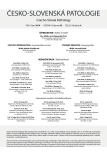-
Medical journals
- Career
Current status of urinary cytology in the evaluation of bladder neoplasms
Authors: Ondrej Ondič 1,2; Robert Slunéčko 1,2; Marián Švajdler - ml. 1 3
Authors‘ workplace: Šiklův ústav patologie, Univerzita Karlova Praha, lékařská fakulta Plzeň a FN Plzeň 1; Bioptická laboratoř s. r. o., Plzeň 2; Oddelenie patológie, Univerzitná nemocnica Louisa Pasteura, Košice 3
Published in: Čes.-slov. Patol., 50, 2014, No. 4, p. 142-145
Category: Review Articles - Uropathology
Overview
Urine cytology is a reliable method for identification and follow up of the patients who develop high-grade urothelial carcinoma. Reactive changes of superficial and intermediate urothelial cells cytologically often mimic low grade urothelial carcinoma. This is the cause of relatively high number of false positive and false negative results. Diagnostic accuracy can be improved introducing different procedures for material handling namely cytospin and liquid based cytology and new diagnostic protocols such as FISH for chromosomal aberrations or mRNA and miRNA analysis. Most recently Next Generation Sequencing for DNA analysis was applied. Availability of clinical information improves the diagnostic accuracy and shortens the time to diagnosis.
Keywords:
cytology - urine - urothelial carcinoma – LBC
Sources
1. Papanicolaou GN, Marshall VF. Urine sediment smears as a diagnostic procedure in cancers of the urinary tract. Science 1945; 101(2629): 519-520.
2. Murphy WM, Grignon DJ, Perlman EJ. Tumors of the kidney, bladder, and related urinary structures. AFIP atlas of tumor pathology, series 4. Washington, DC: American Registry of Pathology; 2004 : 241-343.
3. Murphy WM. Current status of urinary cytology in the evaluation of bladder neoplasm. Hum Pathol 1989; 21(9): 886-896.
4. Hainau B, Dombernowsky P. Histology and cell proliferation in human bladder tumors. Cancer 1974; 33 33(1):115-126.
5. Son SM, Koo JH, Choi SY, et al. Evaluation of Urine Cytology in Urothelial Carcinoma Patients: A Comparison of CellprepPlus® Liquid-Based Cytology and Conventional Smear. Korean J Pathol 2012; 46(1): 68-74.
6. Piaton E, Faÿnel J, Hutin K, Ranchin MC, Cottier M. Conventional liquid-based techniques versus Cytyc Thinprep processing of urinary samples: a qualitative approach. BMC Clin Pathol 2005; 5 : 9.
7. Marganski WA, El-Sirgany Costa V, Kilpatrick MW, Tafas T, Yim J, Matthews M. Digitized microscopy in the diagnosis of bladder cancer: analysis of >3000 cases during a 7-month period. Cancer Cytopathol 2011; 119(4): 279-289.
8. Denice Smith G, Sangle NA, Wilson A, et al. A retrospective review of UroVysion fish interpretations over 8.6 years: a major shift in the patient test population. Diagn Cytopathol 2013; 41(5): 437-447.
9. Dimashkieh H, Wolff DJ, Smith TM, Houser PM, Nietert PJ, Yang J. Evaluation of urovysion and cytology for bladder cancer detection: a study of 1835 paired urine samples with clinical and histologic correlation. Cancer Cytopathol 2013; 121(10): 591-597.
10. Gayed BA, Seideman C, Lotan Y. Cost-effectiveness of fluorescence in situ hybridization in patients with atypical cytology for the detection of urothelial carcinoma. J Urol 2013; 190(4): 1181-1186.
11. Eissa S, Badr S, Elhamid SA, Helmy AS, Nour M, Esmat M. The value of combined use of survivin mRNA and matrix metalloproteinase 2 and 9 for bladder cancer detection in voided urine. Disease Markers 2013; 34(1): 57–62.
12. O‘Sullivan P, Sharples K, Dalphin M, et al. A multigene urine test for the detection and stratification of bladder cancer in patients presenting with hematuria. J Urol 2012; 188(3): 741-747.
13. Bartel DP. MicroRNAs: target recognition and regulatory functions. Cell 2009; 136(2): 215–233.
14. Gottardo F, Liu CG, Ferracin M, et al. Micro-RNA profiling in kidney and bladder cancers. Urol Oncol 2007; 25(5): 387–392.
15. Simonato F, Ventura L, Sartori N, et al. Detection of MicroRNAs in archival cytology urine smears. PLoS ONE 2013; 8(2): e57490.
16. Morrison CD, Liu P, Woloszynska-Read A, et al. Whole-genome sequencing identifies genomic heterogeneity at a nucleotide and chromosomal level in bladder cancer. Proc Natl Acad Sci U S A 2014; 111(6): E672-681.
17. Kawaguchi S, Shigehara K, Sasagawa T, et al. Liquid-based urine cytology as a tool for detection of human papillomavirus, Mycoplasma spp. and Ureaplasma spp. in men. J Clin Microbiol 2012; 50(2): 401-406.
18. DeMay R. Art and science of cytopathology (2nd edn). American Society for Clinical Pathology; 2011 : 437.
19. Jordan AM, Weingarten J, Murphy WM. Can biologic potential be predicted from histologic grading? Cancer 1987; 60(11): 2766–2767.
Labels
Anatomical pathology Forensic medical examiner Toxicology
Article was published inCzecho-Slovak Pathology

2014 Issue 4-
All articles in this issue
- International Society of Urological Pathology (ISUP) Vancouver Classification of Renal Neoplasia 2012
- Current status of urinary cytology in the evaluation of bladder neoplasms
- Morphological and electrophysiological changes of the heart atria in necropsy patients with atrial fibrillation – a pilot study
- Bart´s syndrome associated with epidermolysis bullosa junctionalis and with pyloric atresia. An autopsy case report
- A concise update on prostate pathology
- Update on urinary bladder pathology
- An isolated metastasis to the heart from a malignant phyllodes tumor with osteosarcomatous differentiation
- Czecho-Slovak Pathology
- Journal archive
- Current issue
- Online only
- About the journal
Most read in this issue- Current status of urinary cytology in the evaluation of bladder neoplasms
- Bart´s syndrome associated with epidermolysis bullosa junctionalis and with pyloric atresia. An autopsy case report
- International Society of Urological Pathology (ISUP) Vancouver Classification of Renal Neoplasia 2012
- A concise update on prostate pathology
Login#ADS_BOTTOM_SCRIPTS#Forgotten passwordEnter the email address that you registered with. We will send you instructions on how to set a new password.
- Career
